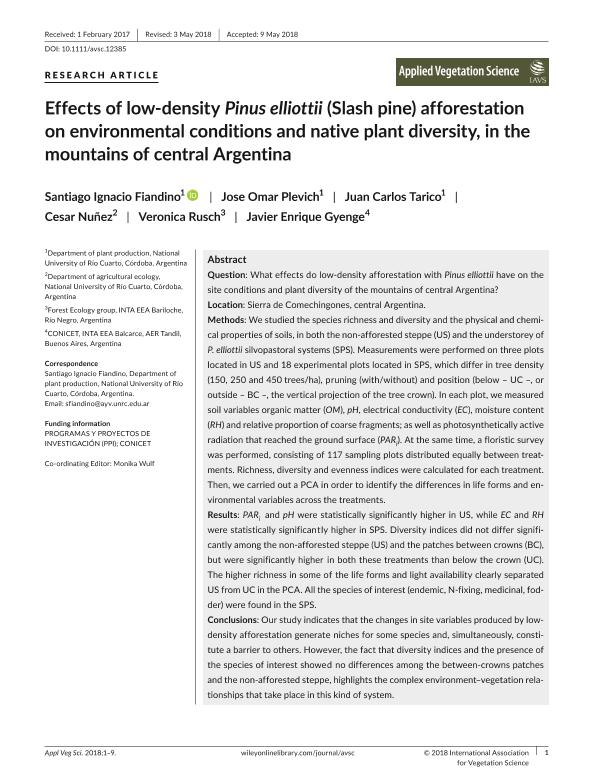Artículo
Effects of low-density Pinus elliottii (Slash pine) afforestation on environmental conditions and native plant diversity, in the mountains of central Argentina
Fiandino, Santiago Ignacio ; Plevich, José Omar; Tarico, Juan Carlos; Nuñez, Cesar; Rusch, Veronica; Gyenge, Javier Enrique
; Plevich, José Omar; Tarico, Juan Carlos; Nuñez, Cesar; Rusch, Veronica; Gyenge, Javier Enrique
 ; Plevich, José Omar; Tarico, Juan Carlos; Nuñez, Cesar; Rusch, Veronica; Gyenge, Javier Enrique
; Plevich, José Omar; Tarico, Juan Carlos; Nuñez, Cesar; Rusch, Veronica; Gyenge, Javier Enrique
Fecha de publicación:
07/2018
Editorial:
Wiley Blackwell Publishing, Inc
Revista:
Applied Vegetation Science
ISSN:
1402-2001
Idioma:
Inglés
Tipo de recurso:
Artículo publicado
Clasificación temática:
Resumen
Question: What effects do low-density afforestation with Pinus elliottii have on the site conditions and plant diversity of the mountains of central Argentina?. Location: Sierra de Comechingones, central Argentina. Methods: We studied the species richness and diversity and the physical and chemical properties of soils, in both the non-afforested steppe (US) and the understorey of P. elliottii silvopastoral systems (SPS). Measurements were performed on three plots located in US and 18 experimental plots located in SPS, which differ in tree density (150, 250 and 450 trees/ha), pruning (with/without) and position (below – UC –, or outside – BC –, the vertical projection of the tree crown). In each plot, we measured soil variables organic matter (OM), pH, electrical conductivity (EC), moisture content (RH) and relative proportion of coarse fragments; as well as photosynthetically active radiation that reached the ground surface (PARi). At the same time, a floristic survey was performed, consisting of 117 sampling plots distributed equally between treatments. Richness, diversity and evenness indices were calculated for each treatment. Then, we carried out a PCA in order to identify the differences in life forms and environmental variables across the treatments. Results: PARi and pH were statistically significantly higher in US, while EC and RH were statistically significantly higher in SPS. Diversity indices did not differ significantly among the non-afforested steppe (US) and the patches between crowns (BC), but were significantly higher in both these treatments than below the crown (UC). The higher richness in some of the life forms and light availability clearly separated US from UC in the PCA. All the species of interest (endemic, N-fixing, medicinal, fodder) were found in the SPS. Conclusions: Our study indicates that the changes in site variables produced by low-density afforestation generate niches for some species and, simultaneously, constitute a barrier to others. However, the fact that diversity indices and the presence of the species of interest showed no differences among the between-crowns patches and the non-afforested steppe, highlights the complex environment–vegetation relationships that take place in this kind of system.
Archivos asociados
Licencia
Identificadores
Colecciones
Articulos(CCT - CORDOBA)
Articulos de CTRO.CIENTIFICO TECNOL.CONICET - CORDOBA
Articulos de CTRO.CIENTIFICO TECNOL.CONICET - CORDOBA
Articulos(CCT - MAR DEL PLATA)
Articulos de CTRO.CIENTIFICO TECNOL.CONICET - MAR DEL PLATA
Articulos de CTRO.CIENTIFICO TECNOL.CONICET - MAR DEL PLATA
Citación
Fiandino, Santiago Ignacio; Plevich, José Omar; Tarico, Juan Carlos; Nuñez, Cesar; Rusch, Veronica; et al.; Effects of low-density Pinus elliottii (Slash pine) afforestation on environmental conditions and native plant diversity, in the mountains of central Argentina; Wiley Blackwell Publishing, Inc; Applied Vegetation Science; 21; 3; 7-2018; 442-450
Compartir
Altmétricas



